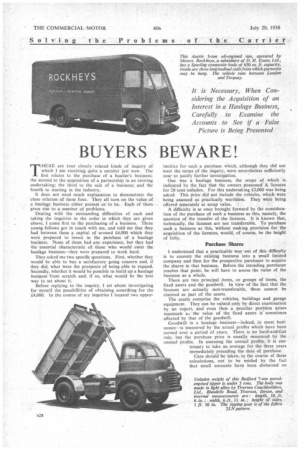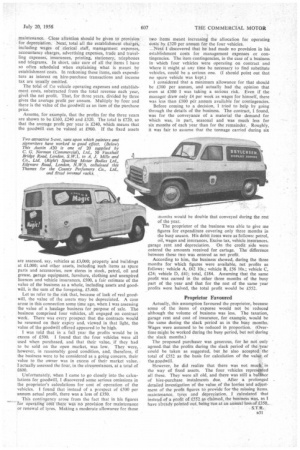BUYERS BEWARE!
Page 62

Page 65

If you've noticed an error in this article please click here to report it so we can fix it.
THERE are tour closely related kinds of inquiry of which I am receiving quite a number just now. The first relates to the purchase of a haulier's business; the second to the acquisition of a partnership in an existing undertaking; the third to the sale of a business; and the fourth to starting in the industry.
It does not need much explanation to demonstrate the close relation of these four. They all turn on the value, of a haulage business either present or to be. Each of them gives rise to a number of problems.
Dealing with the outstanding difficulties of each and taking the inquiries in the order in which they are given above, I come first to the purchasing of a business. Three young fellows got in touch with me, and told me that they had between them a .capital of around £4,000 which they were prepared to invest in the purchase of a haulage business. None of them had any experience, but they had the essential characteristic of. those who would enter the haulage business—they were prepared to work hard.
They asked me two specific questions. First, whether they would be able to buy a satisfactory going concern and, if they did, what were the prospects of being able to expand. Secondly, whether it would be possible to build up a haulage business from scratch and, if so, what would be the best way to set about it.
Before replying to the inquiry, I set about investigating for myself the possibilities of obtaining something for the £4,000. In the course of my inquiries I located two oppor
tunitics for such a purchase Which, although they did not meet the terms of the inquiry, were nevertheless sufficiently near to justify further investigation.
One was a haulage business, the scope of which is indicated by the fact that the owners possessed A licences for 20 tons unladen. For this undertaking £3,000 was being asked. This price did not include the vehicles, which were being assessed as practically worthless. They were being offered separately at scrap value. • A difficulty is at once brought forward by the consideration of the purchase of such a business as this, namely, the question of the transfer of the licences. It is known that, technically, the licences are not transferable. To purchase such a business as this, without making provision for the acquisition of the licences, would, of course, be the height of folly.
Purchase Shares I understand that a practicable way out of this difficulty is to convert the existing business into a small limited company and then for the prospective purchaser to acquire the shares in that business. Before the intending purchaser reaches that point, he will have to assess the value of the business as a whole.
There are two principal items, or groups of items, the fixed assets and the goodwill. In view of the fact that the licences are actually non-transferable, these cannot be claimed as part of the assets.
The assets comprise the vehicles, buildings and garage equipment. They can be valued only by direct examination by an expert, and even then a peculiar problem arises inasmuch a,i• the value of the fixed assets is sometimes affected by that of the goodwill. Goodwill in a haulage business—indeed, in most businesses—is measured by the actual profits which have been earned over a period of years. There is no hard-and-fast rule, but the purchase price is usually measured by the annual profits. In assessing the annual profits, it is customary to take an average for the three years immediately preceding the date of. purchase.
Care should be taken, in the course of these calculations, not to be misled by the fact that small amounts have been disbursed on
maintenance. Close attention should be given to provision for depreciation. Next, total all the establishment charges,including wages of clerical staff, management expenses, accountancy charges, advertising expenses, trade and travelling expenses, insurances, printing, stationery, telephones and telegrams. In short, take care of all the items I have so often scheduled when explaining what is meant by establishment costs. In reckoning these items, such expenditure as interest on hire-purchase transactions and income tax arc usually omitted.
The tofal of the vehicle operating expenses and establishment costs, substracted from the total revenue each year, gives the net profit. That, for three years, divided by three gives the average profit per annum. Multiply by four and there is the value of the goodwill as an item of the purchase price.
Assume, for example, that the profits for the three years arc shown to be £160, £240 and £320. The total is £720, so that the average profit per year is £240, which means that the goodwill can be valued at £960. If the fixed assets
are assessed, say, vehicles at £3,000; property and buildings at £1,000; and other assets, including such items as spare parts and accessories, new stores in stock, petrol, oil and grease, garage equipment, furniture, clothing and unexpired licences and vehicle insurances, £500, a fair estimate of the value of the business as a whole, including assets and goodwill, is the sum of the foregoing, £5,460.
Let us refer to the risk that, because of lack of real goodwill, the value of the assets may be depreciated. A case arose in this connection some time ago, when I was assessing the value of a haulage business for purpose of sale. The business comprised four vehicles, all engaged on contract work. There was every prospect that the contracts would be renewed on their expiry and, viewed in that light, the value of the goodwill offered appeared to be high.
I was told that in a full year the profits would be in excess of £500. I found that the four vehicles were all used when purchased, and that their value, if they had to be sold on the open market, was low. They were, . however, in reasonably good condition, and, therefore, if the business were to be considered as a going concern, their value to the owner was in excess of their market value.. I actually assessed the four, in the circumstances, at a total of £600.
Unfortunately, when I came to go closely into the calculations for goodwill, I discovered some serious omissions in the proprietor's calculations for cost of operation of the vehicles. I found that instead of a prospect of £500 per annum actual profit, there was a loss of £350.
This contingency arose from the fact that in his figures for operating cost the-re was no provision for maintenance or renewal of tyres. Making a moderate allowance for those two items meant increasing the allocation for operating -costs by. £320 per annum for the four vehicles.
....Next I discovered that he had made no provision in his establishment costs for management expenses or contingencies. The item contingencies, in the case of a business in which four vehicles were operating on contract and where it might at any time be necessary to find substitute vehicles, could be a serious one. (I should point out that no spare vehicle was kept.)
I considered that a minimum allowance for that should be E300 per annum, and actually had the opinion that even at £300 I was taking a serious risk. Even if the manager drew only £4 per week as wages for himself, there was less than £100 per annum available for contingencies.
Before coming to a decision, I tried to help by going through the details of the business. The contract, I found, was for the conveyance of a material the demand for which was, in part, seasonal and was much less for six months of each year than for the remainder. Roughly, it was fair to assume that the tonnage carried during six
months would be double that conveyed during the rest of the year.
The proprietor of the business was able to give me figures for expenditure covering only three months in the busy season. His debit items were as follows: petrol, oil, wages and insurances, Excise tax, vehicle insurances, garage rent and depreciation. On the credit side were entered the amounts received for cartage. The difference between those two was entered as net profit.
According to him, the business showed, during the three months for which figures were available, net profits as follows: vehicle A, £62 10s.; vehicle B, 156 10s.; vehicle C, £24; vehicle D, £41; total, £184. Assuming that the same profit was earned in the other three months of the busy part of the year and that for the rest of the same year profits were halved, the total profit would be £552.
Proprietor Favoured
Actually, this assumption favoured the proprietor, because some of the items of expense would not be reduced although the volume of business was less. The taxation, garage rent and cost of insurance, for example, would be the same during the slack period as in the busy months. Wages were assumed to be reduced in proportion. (Overtime might be worked during the busy period, but not during the slack months.) The proposed purchaser was generous, for he not only agreed, that the profits during the slack period of the tear could be taken as suggested, but he also accepted the total of £552 as the basis for calculation of the value of the goodwill.
However, he did realize that there was not much in the way of fixed assets. The four vehicles represented all these. They were all old, and there was still a balance of hire-purchase instalments due. After a prolonged detailed investigation of the value of the lorries and adjustment of the profit figures to provide for the missing items. maintenance, tyres and depreciation. I calculated that instead of a profit of £552 as claimed, the business was. as I have already pointed out, being run at an annual loss of £350. S.T.R. n31




































































































